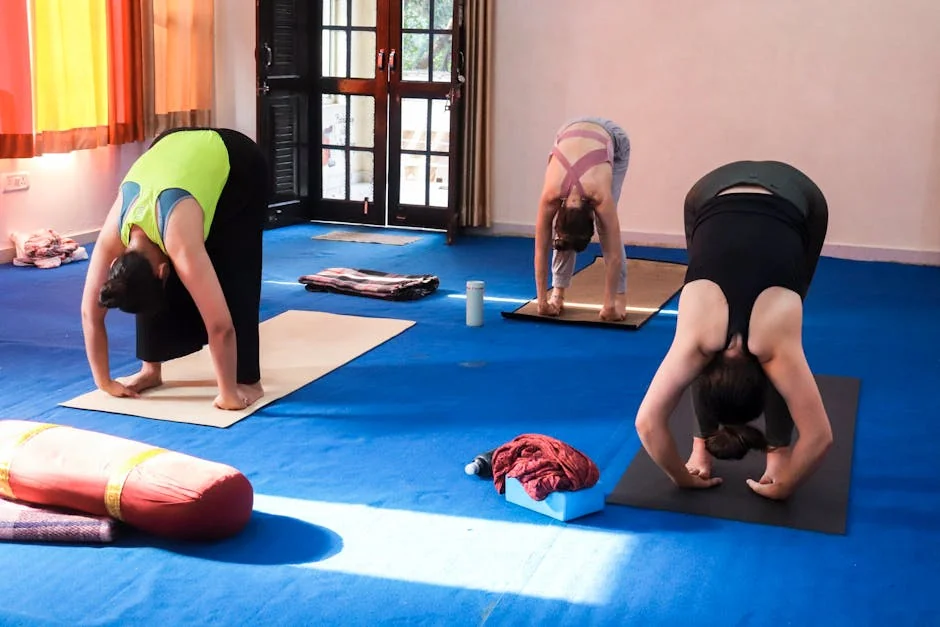Feeling overwhelmed by the constant noise of modern life? You're not alone. In our fast-paced world, the search for a moment of true calm can feel like a distant dream. But what if you could access a profound sense of peace and clarity, right where you are? The secret lies in discovering the best meditation techniques that resonate with you. Forget the misconception that meditation is about emptying your mind or achieving perfection; it's a practical toolkit for training your attention and cultivating a healthier, more resilient mind.
This guide is your personal roadmap. We’ll demystify the practice and explore a variety of powerful methods, from foundational mindfulness to easy guided sessions and calming movement meditations. Whether you're a complete beginner seeking stress relief or someone looking to deepen an existing practice, you’re about to find a technique that fits your lifestyle and goals. Let's begin the journey to find your perfect practice and unlock the focused, peaceful version of yourself that's been waiting to emerge.
Understanding the Foundation: What Makes a Meditation Technique "The Best"?
Before we dive into the specific methods, it's crucial to address a fundamental truth: there is no single "best" meditation technique for everyone. What works wonders for your friend or a famous guru might feel frustrating and unnatural for you. The best technique is the one you will actually practice consistently.
Think of meditation like fitness. Some people thrive in a high-intensity spin class, while others find their flow in yoga or long-distance running. All are valid paths to health. Meditation is the same; different techniques train the mind in different ways.
When exploring the options, consider your personal goals and temperament:
- Your Primary Goal: Are you seeking stress reduction, better focus, emotional healing, or spiritual connection? Your aim can point you toward the most suitable method. For instance, if anxiety is your main concern, you might explore the best guided meditation for anxiety.
- Your Personality: Do you find it easy to sit still, or do you have a lot of physical energy? Are you analytical or more intuitive? Your natural inclinations matter.
- Your Lifestyle: How much time can you realistically commit? Do you need something you can do discreetly at your desk, or do you have a quiet space at home?
The following sections will introduce you to the most effective and widely practiced techniques. Approach them with an open mind, and be prepared to experiment.
Mindfulness Meditation: The Cornerstone of Present-Moment Awareness
If you only learn one meditation technique, mindfulness should be it. It's the foundation upon which many other practices are built. Mindfulness is the basic human ability to be fully present, aware of where we are and what we’re doing, without being overly reactive or overwhelmed by what’s going on around us.
The core of mindfulness meditation is anchoring your attention to a single point in the present moment, most commonly the natural flow of your breath.
How to Practice Mindfulness Meditation
This is a straightforward practice, but its simplicity can be deceptively powerful.
- Find a Comfortable Position: Sit on a cushion, a chair, or the floor. Keep your back straight but not rigid, allowing your spine to have its natural curvature. Rest your hands on your knees or in your lap.
- Gently Close Your Eyes: This helps limit visual distractions.
- Bring Attention to Your Breath: Don't try to control your breathing. Simply notice the physical sensation of the air moving in and out of your body. Focus on the rise and fall of your chest or the feeling of the breath at your nostrils.
- Notice When Your Mind Wanders: Inevitably, your attention will leave the breath and get caught up in thoughts, sounds, or bodily sensations. This is not a failure; it is the practice. The moment you realize your mind has wandered, you have become mindful again.
- Gently Return: Acknowledge the thought without judgment (you might mentally say "thinking" or "wandering") and gently guide your focus back to the sensation of the breath.
- Start with Short Sessions: Begin with just 5-10 minutes a day. Consistency is far more important than duration.
The benefits of this practice are profound. With time, you train your brain to be less carried away by stressful thoughts, leading to reduced anxiety, improved emotional regulation, and a greater capacity to handle life's challenges with clarity. For a deeper dive into this foundational practice, our guide on the best mindful meditation offers further insights.
Guided Meditation: The Easiest Path for Beginners
If the idea of sitting alone with your thoughts feels intimidating, guided meditation is the perfect starting point. It is arguably one of the most easy meditation techniques for a newcomer because it outsources the "directing" part of the practice to an external voice.
In a guided session, a teacher or a recorded audio app leads you through a meditative experience. This might involve a body scan (bringing awareness to each part of the body in sequence), a visualization (like imagining a peaceful forest or a beach), or a loving-kindness practice focused on cultivating compassion. If you're looking for a great place to start, our article on the best guided meditation can help you find the right session for you.
How to Get Started with Guided Meditation
The barrier to entry is incredibly low, making it a fantastic tool for building initial confidence.
- Use a Meditation App: Apps like Calm, Headspace, and Insight Timer offer vast libraries of guided meditations for every goal, mood, and time constraint. They often have specific courses for beginners that explain core concepts.
- Find Videos or Podcasts: YouTube and podcast platforms are filled with free guided meditations. You can find sessions for sleep, anxiety, focus, and more.
- Follow a Script: You can also have a friend read a meditation script to you, or even record yourself reading one to play back later.
The primary advantage of guided meditation is that it gives your busy mind a specific task to focus on, preventing it from wondering, "Am I doing this right?" It’s a supportive training wheel that helps you understand the feel of a meditative state before you venture out on your own.
Focus-Based Techniques: Harnessing the Power of a Single Point
For some, the open-ended nature of mindfulness can feel too vague. If you prefer a more concrete object of focus, focus-based techniques are an excellent alternative. These methods train your "attention muscle" by continually returning your focus to a single, repetitive point. This can be incredibly effective for improving concentration and calming a racing mind.
Two of the most popular focus-based techniques are Mantra Meditation and Candle Gazing.
Mantra Meditation
In this practice, you silently repeat a word, sound, or phrase in your mind. The repetition of the mantra gives your mind a simple, rhythmic task that helps quiet internal chatter. The mantra can be a traditional Sanskrit word like "Om" (a universal sound) or "So Hum" (meaning "I am"), or it can be a English word like "peace" or "calm."
How to practice: Sit comfortably, close your eyes, and begin repeating your chosen mantra silently. When you notice your attention has drifted to other thoughts, gently return to the repetition of the mantra, without frustration.
Candle Gazing (Trataka)
This is a powerful concentration practice that involves fixing your gaze on a single point, typically the flame of a candle. It trains both your mental and visual focus.
How to practice: Place a lit candle at eye level about an arm's length away. Softly gaze at the flame, trying to minimize blinking. After a minute or two, close your eyes and hold the afterimage of the flame in your mind's eye for as long as you can. When the image fades, open your eyes and repeat.
These techniques are ideal for anyone who finds their mind is constantly "on," as the strong anchor gives the thinking mind less room to roam.
Movement Meditation: Finding Stillness in Motion
The image of a person sitting cross-legged in silence is so pervasive that many people assume meditation isn't for them if they can't sit still. This is a myth. Movement meditation proves that mindfulness can be integrated into action, making it accessible for kinesthetic learners and those with high energy.
The goal is not to stop moving, but to bring full, non-judgmental awareness to the movement itself.
Walking Meditation
This is one of the most accessible and beautiful forms of movement meditation. It turns a simple walk into a profound practice.
How to practice: Find a quiet path about 10-20 paces long. Walk slowly and deliberately. Focus all your attention on the physical sensations of walking—the feeling of your feet lifting, moving through the air, and making contact with the ground. Notice the shift of weight in your body. When your mind wanders, gently bring it back to the sensations in your feet and legs.
Yoga and Tai Chi
While often practiced for physical fitness, disciplines like Yoga and Tai Chi are, at their core, moving meditations. They require you to synchronize your breath with deliberate, flowing movements. This union of breath and motion forces the mind into the present moment, creating a state of moving mindfulness that is both calming and energizing.
Building Your Personal Practice: Simple Steps to Make Meditation a Habit
Understanding the techniques is one thing; making them a consistent part of your life is another. The real transformation happens through regular practice. Here are some simple meditation techniques for building a sustainable habit.
Start Unbelievably Small
The biggest mistake beginners make is being overly ambitious. Committing to 30 minutes a day is a recipe for burnout. Instead, start with just 2-5 minutes. The goal is to succeed and build momentum. You can always add more time later.
Attach It to an Existing Habit
Habit stacking is a powerful way to build a new routine. Meditate right after an established habit, like after you brush your teeth in the morning, right before your first cup of coffee, or immediately after you get into bed at night. The existing habit acts as a trigger for the new one.
Create a Dedicated Space
You don't need a whole room, but having a specific corner with a cushion or a chair can signal to your brain that it's time to settle down. This makes it easier to transition into a meditative state.
Be Kind to Yourself (The Most Important Step)
You will have days where your mind feels like a chaotic whirlwind. You will miss sessions. This is all normal. The practice isn't about having a perfectly clear mind; it's about the gentle act of returning. Every time you notice your mind has wandered and you guide it back, you are doing the practice correctly. It is a rep for your brain. Judging yourself for a busy mind is like judging yourself for needing to do another push-up at the gym. If you're struggling with a cluttered mind, a meditation to clear the mind can provide a helpful structure.
Conclusion: Choosing the Best Meditation Techniques for You
The journey to inner peace is not a one-size-fits-all path. The best meditation techniques are the ones that feel sustainable and rewarding to you personally. You now have a toolkit of powerful methods to explore:
- Mindfulness for foundational present-moment awareness.
- Guided Meditation for an easy, supported start.
- Focus-Based practices for a concrete anchor for your attention.
- Movement Meditation for integrating awareness into action.
The only way to discover what truly works for you is to try them. Commit to experimenting with one technique for a week. Notice how it makes you feel during and after the practice. There are no wrong choices here, only different paths up the same mountain.
Your mind is your most constant companion. Learning to work with it skillfully is the greatest gift you can give yourself. Start small, be consistent, and approach your practice with a sense of curiosity and compassion. A calmer, clearer, and more focused you is waiting to be discovered.
The journey to finding the best meditation technique is deeply personal, yet the path is guided by universal principles. As explored, the most effective method is the one you will practice consistently, whether it is focused attention, mindfulness, loving-kindness, or a movement-based practice. The key is not in achieving a perfectly silent mind, but in cultivating a non-judgmental awareness of the present moment. Start small, with just a few minutes each day, and be patient with the process. The profound benefits—from reduced stress and enhanced focus to greater emotional resilience—unfold through regular dedication, not through sporadic effort. You now possess the knowledge to begin. We encourage you to choose one technique that resonates with you and commit to it for a week. The most transformative practice is not the one you read about, but the one you actually do. Your journey toward a calmer, more centered life begins with a single, mindful breath.



